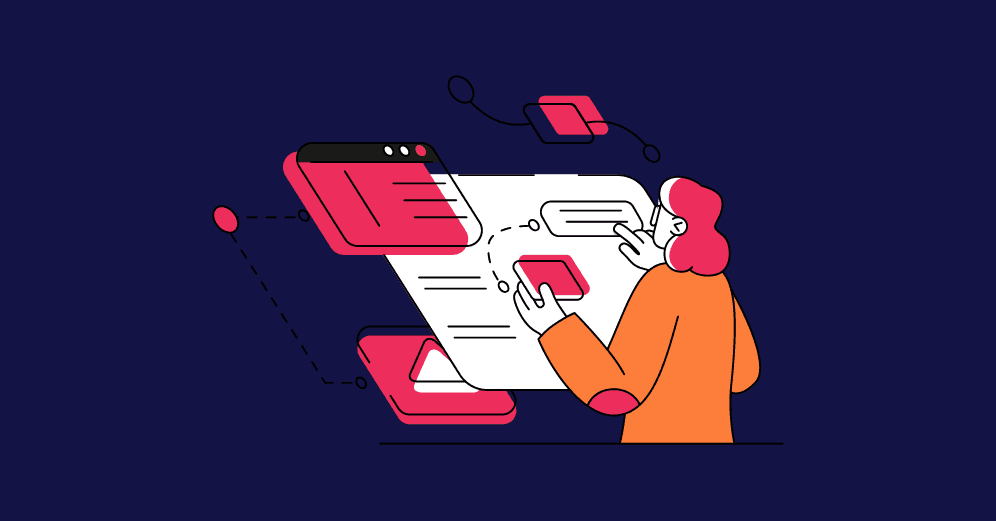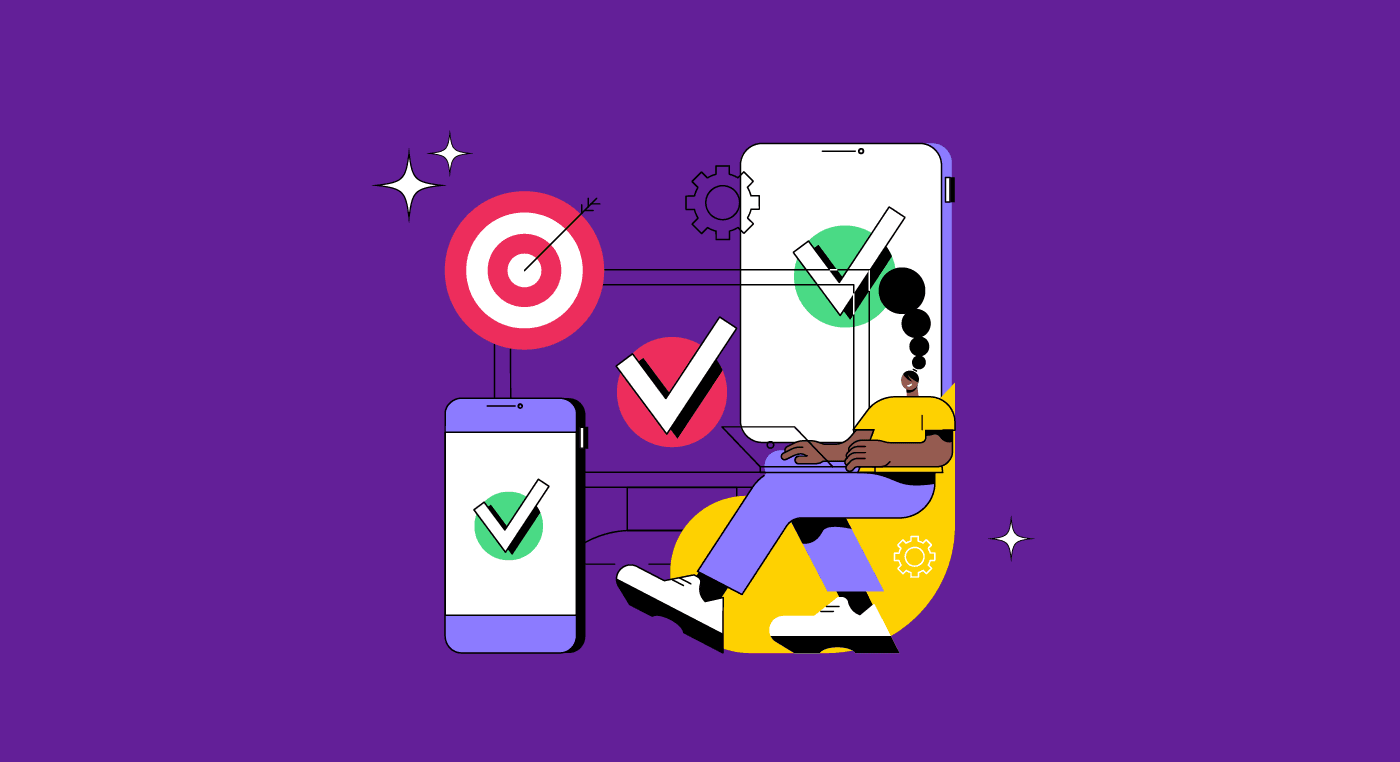Have you ever stopped to wonder why certain apps or websites seem so intuitive and pleasant to use? Why do some online experiences make us smile, while others leave us frustrated? Behind every click, there's a science and an art shaping our digital journey: UX Design.
In an increasingly connected world, UX Design has become not just a trend, but a necessity for businesses. And with this rise, comes curiosity: what does UX Design really mean? Who are the creative minds behind these digital experiences? And, most intriguingly, how can you become one of them?
Dive with us into this material and discover the fascinating universe of UX Design. We will answer all these questions and much more. So, if you're ready to embark on this journey, continue reading!
Beyond Aesthetics: The Essence of UX Design

UX stands for "User Experience". When we talk about UX Design, we are referring to design that is focused on the experience of the user of a particular product or service. The heart of this discipline is not just to ensure a pleasing aesthetic, but to make sure that the user has a positive and meaningful interaction.
To achieve this goal, UX Design delves into understanding the needs, goals, abilities, and limitations of users. It's not just about product design; it's also about aligning the user's desires and needs with the business objectives of the company.
And this is where many are mistaken: UX Design is not confined to the product. It starts with the research of the desired item, permeates the buying interaction, the reception of the product, its use, and even the after-sales service. In short, the entire User Journey is influenced by UX Design.
Furthermore, it's important to mention that UX Design is a multidisciplinary field that encompasses competencies such as:
However, it's pertinent to say that it's not necessary to have any specific background to work in UX Design. But don't worry! We will address this issue later on.
Reading Tip: Unlocking Secrets: The Truth About Graphic Design Vs. UX/Product Design
UX Design and User-Centered Design
UX Design stands out for its commitment to creating products and services aligned with the specific needs of users. In this context, a key concept emerges: User-Centered Design (UCD).
UCD is an iterative design approach that dives deep to understand user demands. It employs various research methods, such as interviews, ensuring that the design truly reflects the needs and desires of the user.
When discussing UCD and UX Design, the relationship is intrinsic. While UCD maintains the focus on the user, UX Design ensures that this attention extends beyond aesthetics, assuring functionality. After all, an attractive visual presentation loses its value if it is not accompanied by practicality and relevance.
Although UX Design has roots older than we might realize and can be applied to tangible products—as illustrated by the example of a simple bowl in the video above—many of us primarily associate this discipline with the digital world. Indeed, when we think of UX Design, we often envision the creation of apps, websites, and software.
In this material, and in other content from Aela, we will address UX Design with a digital focus. Thus, when mentioning the term, we are referring specifically to the development of digital products and interfaces.
And this connection with the digital environment is not by chance. The UX Design market has been experiencing robust growth, and the outlook for this field in the short term is promising.
The UX Design boom
The Nielsen Norman Group (NN/g) conducted a study to answer the question of the progress of the UX field. For that, they have chosen one variable to create a forecast: the number of UX professionals worldwide.

The perspective is that by 2050 the UX profession is expected to grow to about 100 million people.
Part of this growth is because companies are beginning to understand that UX Design adds value to the business and should be part of the company's strategy.
Even with the pandemic and health crisis of 2020, the UX Design market has not stopped growing. Companies had to adapt their products and services to the digital world in this moment of isolation and quarantine.
For this, they had to hire UX and Product Designers to carry out these transformations.
At the beginning of 2020, there were over 1.74 billion websites, and according to Business of Apps, 143.6 billion apps and games were downloaded in 2021. Google Play was responsible for 111.3 billion downloads from that number, while iOS had 32.3 billion downloads.
All of these mobile apps and websites need the skills of a UX designer in one way or another.
Also, as stated by UX design Institute, a report produced by Hired.com showed a 289% increase in requests for UX interviews.
To summarize, the UX Design field is growing, companies are hiring and there is a need for skilled professionals in the area.
Reading Tip: Career Plan In UX: Revealing Your Way To Success
The Multiple Benefits of UX Design

When we think about UX Design, the advantages are clear for everyone involved, from users to UX Designers.
For users: The heart of UX Design lies in providing people with an exceptional experience. In a world saturated with options, individuals yearn for products that not only meet their needs but are also intuitive, enjoyable, and effective. When a product is easy to use and genuinely solves a problem or facilitates a task, it becomes indispensable in people's lives.
For Businesses: The impact of UX Design extends far beyond user satisfaction. Companies that embrace UX practices reap both tangible and intangible benefits, such as:
- Loyalty: Good design keeps people coming back and reduces churn;
- Brand strengthening: A positive user experience enhances brand perception and reinforces its reputation in the market;
- Development efficiency: Reduces rework and facilitates the implementation of features that truly matter;
- Competitive advantage: In fierce markets, UX can be the distinguishing factor that sets a product apart from the rest;
- Profitability: With better user retention and development efficiency, revenues increase and costs decrease.
The growing appreciation of UX in corporate strategies shows that companies are recognizing these benefits, investing more in UX and Product teams, and thereby shaping a more mature market and high-quality digital products.
For UX Designers: The rise of UX Design benefits not just users and businesses but also designers. Working in this field offers:
- Project variety: Engaging in different sectors and challenges;
- Global opportunities: The demand for UX Designers knows no boundaries;
- Strategic participation: More than just designers, they are seen as strategic partners within organizations;
- Social impact: The chance to make a difference, improving people's experiences and enriching their lives through innovative solutions.
What does a UX Designer actually do?

UX Designers are responsible for the overall user experience of a product, and they also help to develop digital products.
But what exactly are their tasks and deliverables?
UX Designers should base their work on 3 major aspects:
- Why?
- What?
- How?
"Why" considers understanding the user's motivations for using the product or service.
The "What" takes into account what the user can do with the product, what its features are and which needs it solves.
Finally, the "How" aligns the product's features with the appropriate aesthetics for its use and good experience.
In this sense, the UX Design process consists of a few steps, which involve:
- Research;
- Definition and idealization;
- Building prototypes;
- User tests;
- Implementation;
- Continuous Improvement.
Within this process, the UX Designer works with:
Conducting Research
At this stage, the UX Designer promotes research to identify the scope of the project, user needs, and possible solutions to problems.
Defining Personas
Based on the research carried out, the UX Designer develops User Personas.
Personas represent users who use or will use a product or service. They do not simply define the brand's target audience but are more detailed and in-depth profiles.
Information Architecture development
In this step, the UX Designer works with the arrangement and hierarchy of information to organize the content in a logical way, focusing on the user experience.
When done efficiently, information architecture helps the user to find what they are looking for easily and quickly.
User Journey and Wireframes
The UX Designer is also responsible for designing the Journey the user will go through while interacting with a product.
In addition, developing wireframes — sketches of the interfaces — is also part of the UX Designer's responsibilities.
Prototyping
Prototypes are more streamlined versions of the final product and can be either high or low fidelity.
Prototyping is essential in the UX Design process for conducting usability tests with users.
Conducting Usability Tests
Finally, the UX Designer is also involved in usability tests, which aim to confirm how well the product performs and how successfully users can carry out their tasks. During the tests, designers can see what works and what doesn't and the features, buttons, micro-interactions, or other content that needs to be improved.
Reading Tip: UX Designer: Challenges and Responsibilities
Possibilities for UX designers

As seen above, UX Design is complex and involves different skills.
However, the UX Designer does not necessarily participate in every process mentioned before. There are subfields of expertise within the entire development flow, such as:
- UX Researcher;
- Information Architect;
- UI/UX developer;
- Usability Analyst;
- UX Writer;
- Product Designer.
Each occupation has different responsibilities and skills within the UX Design process. In this sense, you have the possibility to improve yourself in the subarea that interests you most. Of course, only companies who have reached a good level of UX maturity hire these specialists.
UX Researcher
- Conducts interviews, surveys, and tests;
- Analyzes quantitative and qualitative results of research;
- Develops personas and user journeys and helps on prototypes;
- Presents survey results to team members and stakeholders.
Information Architecture
- Analyzes information from survey results and user tests to understand their mental models;
- Create sitemaps that illustrate how the content should be organized and classified;
- Makes content inventory and content audits;
- Define content hierarchy and navigation;
- Helps create prototypes;
UX/UI Developer
- Works with designers on ideas and identification of potential problems, focusing more on technological possibilities and limitations;
- Develops graphical interfaces (codes);
- Helps create mockups and prototypes;
- Identifies technical difficulties with the user experience.
Usability Analyst
- Works together with the research team, helping with usability tests;
- Apply usability inspection methods;
- Translate observations and insights into action plans;
- Helps develop prototypes and wireframes;
- Identifies usability problems and proposes solutions.
UX Writer
- Works with the research team to better understand personas and their needs;
- Writes simple and effective texts at all user interaction points to help them navigate and complete their tasks;
- Understands how writing and interaction work together to build a coherent narrative in the user journey;
- Defines voice and tone.
Product Designer
This is perhaps the most wanted professional by large companies.
If each of the above possibilities is responsible for a part of the process, the Product Designer is the one who can move from end to end in the project, having both UX Design and UI Design skills.
In addition, by working directly with the product—as the name implies—this professional needs to understand business and specific methodologies, such as Agile, Lean UX, and Design Thinking.
Reading Tip: UX Design: What Are the Possibilities for Working in the Field?
Despite these technical skills, it is also essential that all UX Designers improve their Soft Skills, such as:
- Empathy;
- Curiosity;
- Teamwork;
- Communication.
Is it worth transitioning to UX Design?

The truth is that the answer to this question depends.
Each one lives a different moment in life and must assess whether there are conditions to change careers or not.
However, we understand that there are some fundamental and universal concerns whenever we think about changing roles:
- Is it a field that offers opportunities?
- Are the salaries good?
- Are people who work in the field satisfied? Would they recommend it?
So with that in mind, let's quickly go through these topics in order to provide you with more information so you can decide whether or not to pivot into UX Design.
Opportunities
Earlier in this article, we have already seen that the UX Design job market is still rising, and the prospects are good.
But to bring this data to reality, we can simply search on LinkedIn for UX Designer jobs worldwide.
As a result, 1,064 opportunities appeared for this position is USA (November 2023).
However, if we make a small change in the filter and search for Product Designers, we then there are 1,147 vacancies (November 2023) found throughout the USA.
Also, you can search for remote positions all over the world. After the 2020 Pandemic, many companies have joined the remote work mode, which has brought many opportunities for people from other countries.
We then have 1,382 positions worldwide (November 2023).
Therefore, many companies are looking for UX and Product Designers, proving that the market is hot and, as we said, the trend is for opportunities to grow even more in the upcoming years.
About the salaries
Another question that raises many questions—in all careers—is financial gain.
Using the Glassdoor website, we can do some quick research regarding the average salary of UX Designers and Product Designers.


Of course, salary gains depend on the company and your experience. But having an idea of the average salary can help you decide if it's worth launching yourself on this path.
How satisfied are UX Designers?
Although UX Design can provide solid financial gain, it's not just the amount of money that makes it a great area to work.
In addition to the salary proposal, UX Design can be highly rewarding for professionals.
In fact, according to Measuring, the average satisfaction score for UX Designers is 72%, while the highest score in any profession is 86%.

In addition, another survey conducted by NN/g found that 69% of respondents feel satisfied with a UX design career.

The interesting thing about this survey is that those who said they weren't satisfied didn't say the reason was out of unhappiness with the area itself, but because they were unhappy in the companies where they worked. Whether due to a lack of opportunity to grow or low UX maturity.
How to transition to UX Design?
After learning all that we have presented here about UX Design, you may be wondering at this very moment:
"How do I switch to UX Design and improve my professional life?"
First and foremost, it is important to emphasize that you do not need to have a background in Design or related fields to migrate to UX Design. Many of our students have managed to make this transition, coming from completely different areas, such as:
That is, you do not need academic training to gain the necessary knowledge to work in UX Design.
With this in mind, we invite you to join our Training Program in UX and Product Design: Mastering Interface Design (MID).
With MID, you have a complete program that will provide you not only with technical knowledge but also practical experience. That is, during the program, you will carry out practical projects that will make up your first portfolio in UX Design.
In addition, you will have a team of high-level mentors, with many years of international experience in the field to answer questions and talk about career and the challenges of the profession and the migration process.
Besides all this, you will have access to an extremely active community of students who share doubts, processes, and even job openings in the field.
Apply now, come study with us and transform your professional life with UX and Product Design:








